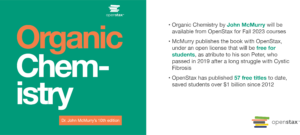Organic chemistry is one of the toughest college courses—and one of the most expensive.
For students who struggle to pay for the high cost of the learning materials, there is good news: Next year, the top-selling organic chemistry textbook will be free as an open educational resource (OER).
Projected savings to students in the first year alone: $10 million.
This windfall to learners is possible thanks to its author, John McMurry, who is working with OpenStax to openly license the 10th edition of his seminal work.

The emeritus professor of chemistry and chemical biology at Cornell University says making the book freely available is a tribute to his son, Peter, who died in 2019 at the age of 51 from cystic fibrosis. While others have established scholarships in the name of loved ones, McMurry says this was a unique gesture.
“He was a remarkable person in so many ways—and this is something he would have wanted,” says McMurry of his son, who he plans to honor with a dedication page and photo in the new edition of the book. “It’s wonderful that it will help students.”
First published in 1984 by Cengage Learning (Brooks/Cole), McMurry’s Organic Chemistry has been translated into many languages and used by 1 million students in its first nine editions. As he was preparing to write an updated version, McMurry reviewed the contract with his publisher and discovered that the book’s copyright returned to him after 30 years.
This left McMurry free to find another outlet. He chose OpenStax, an educational technology nonprofit run out of Rice University, to make his book available at no cost as a digital download and at an affordable price in print.
The international bestselling book has already had a tremendous impact on pre-med and other science students who are required to take the gateway course, says David Harris, editor-in-chief of OpenStax.
“John McMurry is known for his incredibly clear, economical explanations, and great visualization,” Harris says.
In the revision process (which happens about every five years), McMurry goes over every page to make language even sharper, says Harris, and new scientific discoveries are incorporated. Also, as all of OpenStax resources are born digital, this 10th edition will also have interactive content.
Publishing McMurry’s widely revered book is significant for OpenStax, Harris says.
“It conveys that OER is now in the mainstream,” he says. “It puts to rest finally any question of ‘quality’ difference between OER and commercial material.”
Authors are beginning to embrace the scale impact that widely available OER can have on students, Harris adds. The hope is that McMurry’s decision will prompt others, who may have been reluctant, to consider the benefits of OER.
“Anyone can do this,” McMurry says, noting that he stumbled across the copyright expiring, allowing him to make the book open. “As the word gets out, I suspect it will happen much more often.”
Since 2012, OpenStax has published 57 free, openly licensed titles with plans to expand its titles to 67 by 2024. Its materials have been used by more than 6 million students, saving them more than $1 billion.